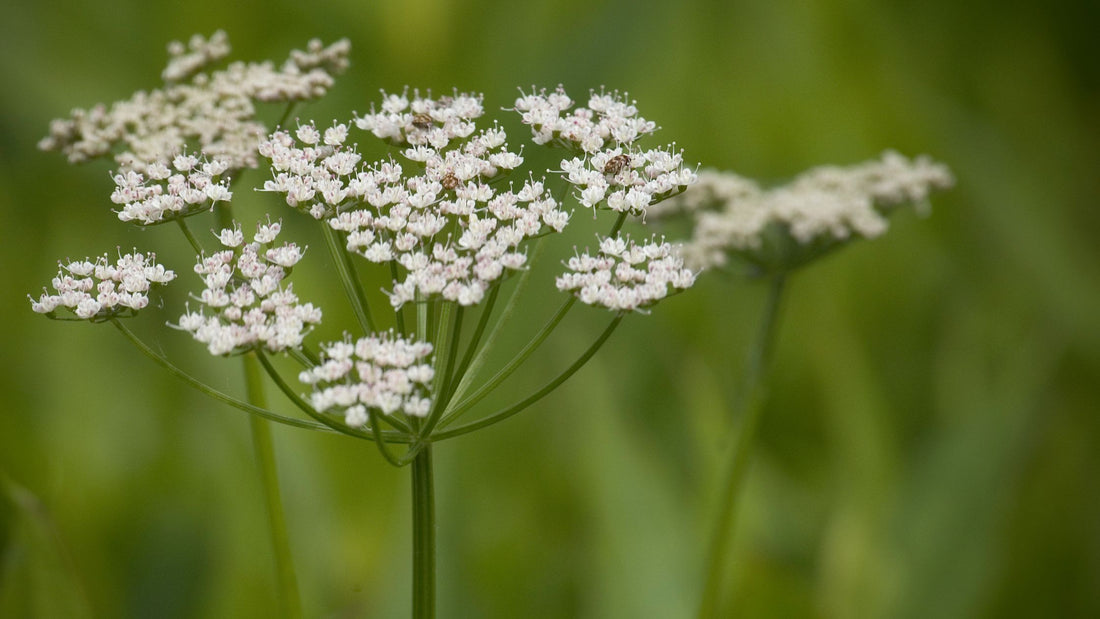Managed Fires Target a New Nonnative Invasive Plant at Three Waters Reserve
The week before Christmas is usually focused on coordinating parties, preparing a feast and fussing over where to seat the family. However this year, the Three Waters Reserve family came together to address a challenging new plant that is taking southern Wisconsin by storm. Landowners need to get to know about this invasive weed. When present, it prevents the germination of many native plant species and can take over the plant community.
Japanese hedge parsley has arrived in our neighborhood. The plant has bristly seeds that cling to the fur of deer, racoons and also to the clothing of hikers. As a result, it started showing up along the deer trails where the seeds had fallen from the fur of passing white tailed deer and grew into trail-bordering thickets.

Intern Eliana Riemer monitoring the Japanese hedge parsley population in 2022, prior to initial control treatments. These initial observations help measure treatment effectiveness as part of an adaptive management strategy.
During mid-summer we mowed the second-year plants, which as a biennial, send up a flowering head that matures to produce abundant seeds. The seeds fall to the ground, sprouting in late summer and growing as a basal rosette—an evergreen young plant that during the following growing season sets a deep, tangled mature root. The plant closely resembles its next of kin: A thin version of the domestic carrot. After a full year of growth in this rosette stage, during the spring of year two, the flowering head ascends, flowers, and the life cycle recycles.
Most of the basal rosettes do not yet develop adequate root stores of carbohydrates until nearing the end of the first year of growth. The prescribed burning conducted last week at Three Waters Reserve provided a rare December opportunity to torch the young rosettes. The goal was to try to use fire as a tool to greatly reduce the tens of thousands of rosettes. The results appeared to be very successful as fire not only burned up the green leaves, but in many locations, fire burned through the oak leaf litter and actually consumed most of the plants’ shallow rooted seedlings in entirety.

December 2023's prescribed burn at Three Waters Reserve in Brodhead, WI. Photo credit: Craig Ellefson
Fire has a rejuvenating function in most ecosystems of North America including the oak savanna’s, prairie, various types of wetland and even forests. Many shallowly-buried native plant seeds respond to the heat the next spring by germinating and flourishing for the first and several years following the burn. The spread of special plants like Spiderwort, St. John's Wort, Shooting Stars, and many other native plant species can be seen as a result.
One way to combat the spread of Hedge Parsley and other non native and invasive weeds is to diversify plant communities. The Winter Frolic at Three Waters Reserve (January, 27 from 12-4pm, RSVP) provides an opportunity for attendees to participate in this very important step in the restoration of healthy ecosystems. During the event, participants will have the opportunity to help spread bags of collected wildflower seeds throughout the property. Each bag will be color coded in accordance with a vegetation map of the reserve. Somewhat like a treasure hunt, but with a delayed treasure, spreading the bags of seed will result in more wildflowers in the future.

A trained volunteer captured at just at the right moment appears to engulfed by the flames. Photo credit: Craig Ellefson
This December’s fire was not only effective, but also beautiful. There is something to be said about the dark stalwart oak forms emerging from the mysterious shrouds of smoke. Oaks are truly the living manifestation of the mystical phoenix. As they endure fire, their acorns germinate rapidly in the ash left behind afterwards. The fire stimulates the growth of tens of thousands of oak seedlings so TWR may continue to have a healthy oak savannah in the future. A percentage of acorns will become teenage and mature adult oaks. Mowing of the lawns under the oaks at TWR have created a geriatric ward of older oaks. Most are about the same age—150-225 years of age, and have the same vulnerabilities to storm damages, insect depredations and diseases. This will take time, but next fall look for the thousands of baby oaks. In five years, look for the hundreds of teenage oaks. And, envision several decades from now the older oaks co mingling with a younger generation that will move into the canopy as the storms, tornado’s take out the old cronies.


